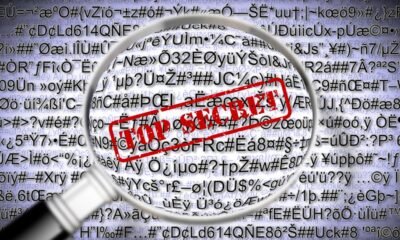Technology
Do AirTags Need to Be Charged? A Comprehensive Guide

Contents
Understanding AirTags and Their Power Source
AirTags are small, circular tracking devices developed by Apple to help users locate their personal items, such as keys, wallets, and bags, using the Find My app. These devices leverage Bluetooth technology to communicate their location to nearby Apple devices, creating a robust and extensive tracking network. AirTags are particularly useful for individuals who frequently misplace their belongings, providing peace of mind and ease of retrieval.
Unlike many other electronic devices, AirTags do not require traditional charging. Instead, they are powered by a replaceable CR2032 coin cell battery. This battery type is known for its compact size and reliable energy output, making it a suitable choice for small, portable devices like AirTags. On average, a CR2032 battery can power an AirTag for approximately one year under typical usage conditions.
Several factors can influence the actual battery life of an AirTag. High-frequency use, such as frequent location requests or active tracking, can lead to a shorter battery lifespan. Environmental conditions, such as extreme temperatures, can also impact the battery’s performance. Despite these variables, the one-year estimate generally holds true for most users.
Replacing the battery in an AirTag is a straightforward process that requires no specialized tools. To replace the battery, simply press down on the stainless-steel back cover and rotate it counterclockwise until it stops. Lift off the cover to access the old battery, remove it, and insert a new CR2032 battery with the positive side facing up. Finally, reattach the cover by aligning it and rotating it clockwise until it clicks into place.
The ease of battery replacement ensures that AirTags remain a convenient and low-maintenance solution for item tracking. By understanding the power source and maintenance requirements, users can maximize the utility and longevity of their AirTags without the hassle of frequent charging.
Maintaining and Replacing AirTag Batteries

Understanding the maintenance and replacement of AirTag batteries is crucial for ensuring their optimal performance. AirTags utilize CR2032 lithium coin batteries, which are designed to last for approximately one year under typical usage conditions. However, the actual battery life can vary based on factors like tracking frequency and environmental conditions.
One of the key indicators that your AirTag battery needs replacement is a notification from the Find My app. The app will alert you when the battery is low, allowing you to plan for a timely replacement. Additionally, if you notice a decline in the AirTag’s performance, such as delays in location updates or frequent disconnections, it may be time to inspect the battery.
Step-by-Step Guide to Replacing AirTag Batteries

Replacing the AirTag battery is a straightforward process. Follow these steps to ensure a safe and effective battery replacement:
1. Twist and Open: Firmly press down on the stainless steel back of the AirTag and twist it counterclockwise until the cover releases.
2. Remove the Old Battery: Carefully take out the depleted CR2032 battery. Avoid using sharp objects that might damage the AirTag or the battery compartment.
3. Insert the New Battery: Place a new CR2032 battery into the compartment with the positive side facing up. Ensure it is seated correctly to avoid any malfunction.
4. Reassemble the AirTag: Align the stainless steel cover with the AirTag and twist it clockwise until it locks back into place.
It is essential to use high-quality CR2032 batteries from reputable sources to maintain the AirTag’s functionality. These batteries are widely available at electronics stores, supermarkets, and online retailers.
Environmental Considerations and Battery Life Maximization

Proper disposal of old batteries is an important environmental responsibility. Many retail stores and recycling centers offer battery recycling services. Avoid disposing of batteries in regular household waste to prevent environmental contamination.
To maximize the battery life of your AirTags, consider minimizing unnecessary location tracking. For instance, you can disable tracking for items that are stationary for extended periods. Regularly updating the Find My app and firmware can also help improve battery efficiency.
By following these guidelines, you can ensure that your AirTags remain operational and eco-friendly throughout their usage cycle.
Post Disclaimer
The information contained in this post is for general information purposes only. The information, including images, is provided by Do AirTags Need to Be Charged? A Comprehensive Guide, and while we endeavor to keep the information accurate, we make no representations or warranties of any kind, express or implied, about the completeness, accuracy, reliability, suitability, or availability with respect to the website or the information, products, services, or related graphics contained on the post for any purpose. Please note that images used in this post may be included for entertainment purposes and do not necessarily represent factual or real-life scenarios.
Technology
Do YouTube Videos Help Contractors to Generate More Leads?

Today, every business in this digital age is looking for newer avenues to connect with potential clients. The same holds true for contractors in Australia. Today, having an online platform that can aid business growth is a must-have. YouTube is one of the most dynamic mediums for sharing services or products with clients. The question arises: do YouTube videos help contractors get more leads? This blog post attempts to find an answer.
Contents
Expanding Reach through Visual Content
First, the videos on YouTube enhance a contractor’s reach. No doubt, traditional marketing is helpful but often limits the reach of the audience. In contrast, the YouTube user base is vast; hence, contractors will have the advantage of reaching a broad audience. Videos on YouTube can explain expertise, completed projects, and details regarding the contracting field. The viewers are more likely to remember them and contact them whenever their services are required.
Building Trust and Credibility
YouTube videos also build customer trust. Customer feedback and work process videos demonstrate contractor openness and trustworthiness. A video showing the step-by-step procedure for home remodelling would educate viewers and build contractor trust. Lead generation requires trust, and video content is one of the best building methods. Those who lack resources can enlist the help of professional marketing services such as King Kong.
Engaging Content for Better Conversion
Engaging videos are the key to converting from just viewers to leads. However, YouTube lets contractors create engaging and instructive videos. Contractors may attract customers with narrative and clear calls to action. A video depicting a project before and after, with a call to action to visit their website or contact them, may work wonders.
Optimising for Search and Visibility
Search engine optimization also boosts YouTube lead creation. Contractors’ videos may rank on YouTube and Google for any search query since their titles, descriptions, and tags are designed for target keywords. This increases the likelihood that prospective contractors’ clients will watch their videos. Additionally, ordered playlists and thumbnails may boost click-through rates.
Showcasing Unique Selling Points
YouTube allows contractors to highlight their USPs. There is always something different about every contractor, be it some admittedly specialised skill, years of industry experience, or even some way of attacking a different project. Contractors can use videos to communicate that difference clearly. Emphasising what sets them apart, contractors, in turn, will attract clients in niche markets that value the particular expertise of the contractor.
Cost-Effective Marketing Strategy
Compared to all other lead generation strategies, YouTube is highly cost-effective. Although making videos can involve some uphill development of time and resources, the long-term benefits compensate for the costs incurred. Once uploaded, videos generate views and potential clients without much additional expenditure. This makes YouTube quite attractive for contractors looking to maximise their marketing budget.
Leveraging Influencer Collaborations
Finally, contractors can make the most out of influencers or experts in their field. Several followers behind the lead of an influencer can only provide some exposure specifically for contractors. If, for instance, one collaborates with a home improvement influencer, then there will be an avenue for the contractor to be available to people who may already need their services. Such a relationship goes a long way in boosting lead generation for contractors.
Indeed, a contractor can draw more leads from YouTube videos. Reach out to the target audience, develop trust with your prospects, optimise any content, and more. Use the power of YouTube now, and your contracting business will be stronger than ever.
Post Disclaimer
The information contained in this post is for general information purposes only. The information, including images, is provided by Do YouTube Videos Help Contractors to Generate More Leads?, and while we endeavor to keep the information accurate, we make no representations or warranties of any kind, express or implied, about the completeness, accuracy, reliability, suitability, or availability with respect to the website or the information, products, services, or related graphics contained on the post for any purpose. Please note that images used in this post may be included for entertainment purposes and do not necessarily represent factual or real-life scenarios.
Technology
10 Reasons Why You Need to Hire a React Developer Today

Are you struggling to engage React developers for your upcoming projects? Are you surprised to see the huge demand for React developers? Let’s remove this uncertain condition by giving you the 10 reasons for hiring React developers for your projects.
But before we proceed to the main body of the blog, let’s review the beginning of the process – the first paragraph.
React is a library of JavaScript and has become one of the most effective tools for creating applications with great performance, scalability, and interactivity. Every organization prefers React over other frameworks and that’s why there is a very high demand for React developers in the industry.
Now, let’s get to the core business and learn reasons why hire React developers for your next project.
- Efficient Development Process
With React, you can align and speed up your development process. React helps the developers develop components that can be used in other applications, and this makes the development process easier and more efficient.
These components can be used at different phases in the development cycle hence increasing the development rate since less time will be used in rewriting the same line of codes.
Further, it allows your team to focus on enhancing the overall experience.
- You Get Rich User Interfaces
Today’s clients demand clean but interactive designs that captivate their users’ attention and make them do a transaction. With React, it is possible to build rich user interfaces by implementing complex UIs that make the overall user experience extremely effective.
- Flexibility of React
Unlike other libraries, React is highly flexible and can be integrated with libraries and frameworks, allowing developers to bring innovation to the project using other technologies. This flexibility makes React an excellent choice for entrepreneurs looking for a tech that gives them maximum output with less input.
- React Makes SEO Easier
Compared to other JavaScript frameworks, React supports server-side rendering, which makes web applications more friendly for SEO. A React developer can improve your site’s performance and make it easier to get explored by search engines, thus increasing your organic traffic.
- Strong Community Support
React has strong community support and a vast ecosystem that helps developers with resources, libraries, and tools to tackle the advancements in the technology.
- Future-Proof Technology
Everyone knows that React is supported by Facebook which is a strong platform. This ensures that the future of React is bright and your tech stack will be immune to obsolescence and will be ready to incorporate the latest updates.
- Performance Optimization with Virtual DOM
React’s Virtual DOM is used to enhance the speed of applications by only rendering the necessary changes, not the entire page. This can go a long way in enhancing the time it takes to load a page and elevates the satisfaction level of the users.
- Cross-Platform Development
React Native allows building applications on multiple platforms. It enables developers to build cross-platform applications i.e. for iOS and Android with the same codebase. Having a React developer on board means getting access to this technology and being able to have mobile development without having to create new teams.
- Cost-Effective
Since React has many reusable components, a simplified process of creating applications, and the possibility of working on several platforms at once, it proves to be a cost-effective development method.
This also gives you time-saving and demands less maintenance in the long run.
- State Management with Redux
Using React means that your developer will be able to effectively manage the state by integrating Redux. Integrating Redux with your system gives you control over the application state.
It ensures efficient data handling, and easy management of debugging errors in large-scale applications.
Conclusion
There can be multiple reasons for hiring React developers but the top reason is its interactive user interfaces and reusable UI components. Once you finalize that you are to make your project on React, the above-given reasons will help you in engaging professional developers.
Post Disclaimer
The information contained in this post is for general information purposes only. The information, including images, is provided by 10 Reasons Why You Need to Hire a React Developer Today, and while we endeavor to keep the information accurate, we make no representations or warranties of any kind, express or implied, about the completeness, accuracy, reliability, suitability, or availability with respect to the website or the information, products, services, or related graphics contained on the post for any purpose. Please note that images used in this post may be included for entertainment purposes and do not necessarily represent factual or real-life scenarios.
Technology
Technologies Playing an Important Role in Imposing Deepfake Regulations

The need for stringent regulations on deepfakes has also increased with advancements in deepfake technology. Deepfakes, manipulated photorealistic media, have resulted in immense risks regarding spreading misinformation, harassment, and fraud. Governments across the world are also coming forward with deepfake legislation to fight all these problems.
Technologies have a very crucial role in enforcing such regulations by allowing the detection, tracking, and prevention of crimes related to deepfakes. This way, regulatory authorities can effectively handle the fast-emerging threat of deepfakes while ensuring responsible AI usage. Now, let us look into the various roles of different technologies in enforcing deepfake legislation and what it will spell for society.
Contents
- 1 Understanding Deepfake Regulations and Their Importance
- 2 Role of AI and Machine Learning in Detection
- 3 Blockchain Technology for Traceability and Accountability
- 4 Collaborations Between Tech Companies and Regulators
- 5 Public Awareness and Education Initiatives
- 6 Future of Deepfake Regulations and Technology
- 7 Wrapping It Up
Understanding Deepfake Regulations and Their Importance
Deepfake regulations refer to the laws and policies devised to control the development and distribution of deepfakes. Deepfakes have progressed much faster than the regulation of such technologies, and hence an elaborate piece of legislation on deepfakes is badly needed urgently. Governments now are waking up to realize how much damage deepfakes pose, especially in the political world- manipulative videos that spread false information and alter public opinion.
For instance, last year, the Deepfake Act was introduced in the United States to criminalize malicious deepfakes for those who create these with some form of deceptive intent. Thus, it is indispensable for individuals and institutions alike to understand these regulations as they navigate the increasingly manipulated media landscape and digital content complexity.
Role of AI and Machine Learning in Detection
Artificial intelligence and machine learning are frontline leadership technologies that are constantly enforcing new deepfake regulations. Through these, sophisticated detection algorithms can be developed to scan through video and audio content for potential manipulation signs. For instance, AI models will look at inconsistencies in the movements of a face or voice patterns, among other audiovisual clues of a deepfake.
These models become adept in detecting malicious content after training on massive amounts of genuine and deepfake media. Deepfake laws necessitate the application of detection technologies by law enforcement agencies as well as regulatory bodies so that both compliance and public safety against deepfake crimes are ensured. Finally, it is an integration of AI detection in social media platforms, which reduces the effectiveness of very harmful content spread among users.
Blockchain Technology for Traceability and Accountability
The use of blockchain technology forms one of the innovative solutions for enforcing deepfake legislation. It uses a decentralized ledger that assists traceability of digital content origins in an immutable record of creation and modification. Traceability is essential in identifying the sources of origin of deepfake videos and responsible creators of such malicious content.
For instance, where original media have been blockchain-based system registered and timestamped, such future alterations would then be visible and verifiable. As stricter regulations for deepfakes are established, blockchain technology’s adoption syncs with the accountability of creators towards content to prevent these deepfake crimes from happening. While this will facilitate compliance with the law, the approach also enables consumers to rely on the authenticity of digital media.
Collaborations Between Tech Companies and Regulators
To effectively implement deepfakes regulations, there is a need for synergy between tech companies and bodies of regulation. Many tech firms already work on detection and risk mitigation tools related to deepfakes. Such as developing customized systems to detect deepfakes, for example, in collaboration with AI developers and law enforcement agencies according to extant deepfake laws.
Additionally, the developing tech companies can collaborate in making the public aware of the risks of deepfakes and how to identify them. Through such collaboration, not only does the legislation in terms of enforcing deepfakes get stronger, but the responsible use of technology also promotes responsible use. Hence, regulators working hand in glove with tech firms can take steps toward enhancing a safer digital environment.
Public Awareness and Education Initiatives
Thus, education and a higher level of public awareness of deepfake regulations are important measures in making such regulations effective. Awareness programs will enlighten individuals as to what deepfakes are, how dangerous they can be, and why following deepfake laws is important. In other words, by raising awareness about the dangers involved with deepfake content like misinformation and identity fraud, educational programs educate users about what kinds of media are suspicious so that they may raise an alarm.
In addition, education and educational programs can provide transparency about the applied technologies used for detection and therefore be able to enhance the capabilities of the public to be able to distinguish true from false. Public awareness campaigns have a very important role in forming a culture of responsibility and vigilance against deep fake crimes as legislation about deep fakes is in constant development.
Future of Deepfake Regulations and Technology
As technology evolves, so will the regulatory environment over deepfakes. Future regulations would implement these advancements in AI, machine learning, and blockchain for advanced detection and accountability practices. Additionally, this integration would make international cooperation and coordination crucially important as deepfake laws begin to take root around the world. Integration of emerging technologies into the regulatory environment will bring along aspects that ensure legislation will be in place in line with technological advancements. Further, efforts to public education with ongoing critical contributions will be essential for a technically enlightened citizenry with the ability to filter through the labyrinth of digital content. Ultimately, the future of deepfakes in regulation depends upon the complementarity between technology, legislation, and public awareness.
Wrapping It Up
Since technology has its role, it will be forcing severe regulations with deepfake. The increasingly apparent threat of false media can only be effectively battled by society if it succeeds in developing advanced methods for detection, and blockchain traceability, and if the tech and regulatory sides cooperate better towards reducing crimes linked with deepfakes and responsibly utilizing this massive technology. As legislation keeps on developing regarding deepfakes, education, and awareness will form an indispensable aspect of creating a safer digital landscape. Collaborating with technology, brings us closer to an era where deepfakes are used responsibly, openly, and to everyone’s advantage.
Post Disclaimer
The information contained in this post is for general information purposes only. The information, including images, is provided by Technologies Playing an Important Role in Imposing Deepfake Regulations, and while we endeavor to keep the information accurate, we make no representations or warranties of any kind, express or implied, about the completeness, accuracy, reliability, suitability, or availability with respect to the website or the information, products, services, or related graphics contained on the post for any purpose. Please note that images used in this post may be included for entertainment purposes and do not necessarily represent factual or real-life scenarios.
-

 Entertainment9 months ago
Entertainment9 months agoWhat is Masqlaseen? A Complete Overview
-

 Entertainment8 months ago
Entertainment8 months agoWhat is Moye Moye? Understanding the Serbian Phrase and its Meaning
-

 Entertainment7 months ago
Entertainment7 months agoWhat is soymamicoco? A Complete Guide
-

 Technology7 months ago
Technology7 months agoWhat is an XCV Panel? A Guide to Its Uses and Benefits
-

 Entertainment7 months ago
Entertainment7 months agoIs Ztec100.com Your One-Stop Shop for Digital Solutions?
-

 Business7 months ago
Business7 months agoWhat is Roadget Business?
-

 Entertainment7 months ago
Entertainment7 months agoWhat is 06shj06? – Uncover The Mystery
-

 Entertainment7 months ago
Entertainment7 months agoWho is Elon Musk? – Unveiling the Visionary Entrepreneur




